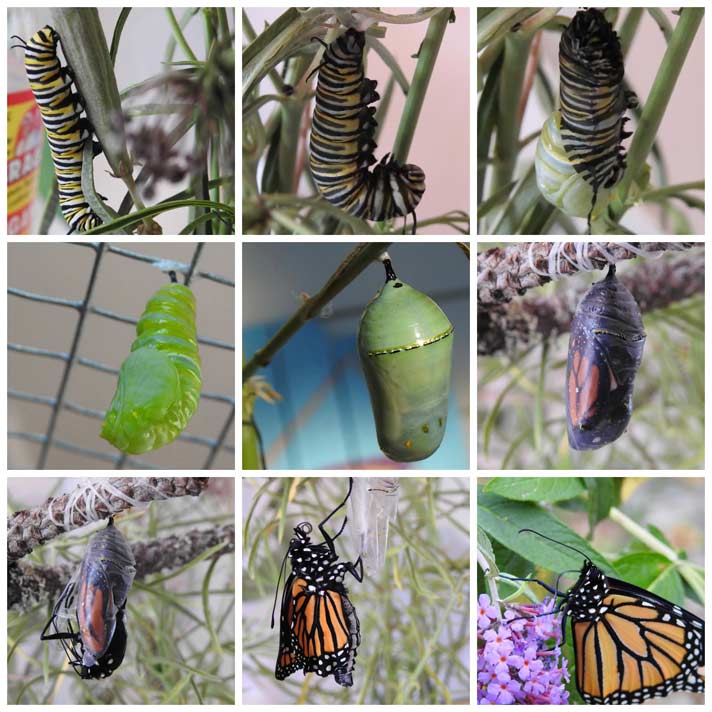Love Thy Pollineighbor – October 2017
Watching a monarch metamorphosis is mind-blowing. Work deadlines, family time, and personal care all take a temporary backseat to what I view as a mesmerizing marvel. The fact that a single egg, only slightly larger than the period at the end of this sentence, in four days, turns into the tiniest milkweed-munching caterpillar imperceptible to the average eye, and then molts five times, growing 30 times her original size in 14 days, is already astonishing. But the wonder doesn’t stop there. A brilliantly striped, plump caterpillar attaches, upside-down to a fixed object, forms a J-shape, then contracts, twists, and writhes into a dazzling green chrysalis with glistening gold dots, which then, over the next 10 days, turns black revealing orange wings. The butterfly ecloses (emerges) from the chrysalis shell like an acrobat swinging down from a wire, desperately holding on. She hangs there stitching her split proboscis together, while her soggy wings harden. I’ve witnessed, dozens of times, the metamorphosis from egg to caterpillar to chrysalis to adult butterfly, and I am still unable to turn away. It’s zentertaining awe-incapacitation.
When I really think about it—the transformation—I’m inspired by nature’s ability to thrive despite unconscionable odds. The monarch is not only fighting for survival from the natural world but is also bumping up against human interference through habitat destruction. Monarchs are gravely declining due to the loss of native milkweed—an obligate host plant—the only food the caterpillars will eat. Already less than 5% survive to adulthood due to countless predators that devour or parasitize the eggs and caterpillars. Fortunately, there is a burgeoning grassroots movement of citizen scientists planting monarch waystations (gardens with milkweed and forage flowers) and rearing monarchs indoors. I believe this movement will help save the monarch.
The great migration begins early fall when the Western monarchs journey to their overwintering sites along the central or southern coast of California, and the Eastern monarchs brave a difficult flight to their overwintering sites in the Oyamel Fir forests of central Mexico traveling roughly 3000 miles. The monarchs that leave Oregon now are considered the super generation. Whereas as most monarch butterflies live 2-6 weeks, the super generation will live up to nine months spending most of that time in a state of torpor using only minimal fat reserves at their overwintering sites. Around Valentine’s day, they start looking for love (okay, not love), and by March or April the female begins the journey north spending her final days searching for milkweed upon which to lay her eggs. The mysterious migration north continues with each subsequent generation arriving to a place they’ve never before been but from where their ancestors came.
To date, I’ve released more than twenty monarch butterflies raised indoors. Releasing each one brings about both trepidation and joy, much like a concerned mother sending her child out to make her mark on the world. As they fly from my fingers, I bid them farewell, a safe journey, and a good life.
The collage below shows a monarch’s metamorphosis from 5th instar (stage) caterpillar to chrysalis to adult butterfly (left to right and top to bottom).
For those of you following Jacksonville’s Bee City initiative, the date of our City Council meeting has changed. We are now on the agenda for October 17. We would be thrilled if you came and showed your support!

 When she’s not working, volunteering, fiddling about the garden, photographing nature, being a pollinactivist, blogging about social and environmental justice, or pawning her eco-children’s book, Kenda, a former Monarch butterfly docent, gets her kicks hanging with her husband, her dog, and the pollineighbors.
When she’s not working, volunteering, fiddling about the garden, photographing nature, being a pollinactivist, blogging about social and environmental justice, or pawning her eco-children’s book, Kenda, a former Monarch butterfly docent, gets her kicks hanging with her husband, her dog, and the pollineighbors.